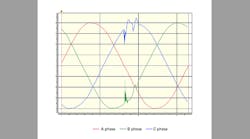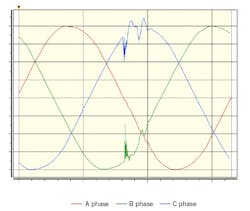By definition, transient voltage events don’t last long. But a single event, if of sufficient magnitude, can destroy a motor. So can events of smaller magnitude that go unnoticed as they cause winding insulation to deteriorate.
We call a voltage event a transient when it lasts only momentarily. The voltage event may be a spike or a dip. A spike can do things like cause overheating or simply punch a hole in the insulation of conductors or motor windings. A voltage dip also can cause overheating, because the motor is going to demand more current when that dip occurs.
Suppose someone asks you if a given motor has been experiencing transient voltage events. How would you know? If lightning struck the building yesterday, you could probably say “yes” with reasonable confidence. But without instrumentation, you really have no way of knowing if that motor got hit by transients or not.
You can’t hook up a digital multimeter (DMM) and have it look backward in time to measure an event that already happened. The only way to know if an event happened is to look at measurements that have been recorded. You want to do this with something more than the high-low recording feature on a DMM. For one thing, that DMM can’t tell you how many transient events it saw (if, indeed, it was fast enough to capture any).
You need something that is fast enough to capture each transient event, and you need something that will tell you when each occurred and how long it lasted. It would be nice to know not only the magnitude of each transient but also what its waveform looked like.
A power monitor fits the bill. It’s unlikely you can have it watch all of your motors, but you can have it watch your critical motor feeders.
If you have any large motors that start across the line but you haven’t been able to get management to spring for a soft starter, a report generated from the power monitor data will show what those motors are doing to the rest of your equipment via the power distribution system.





